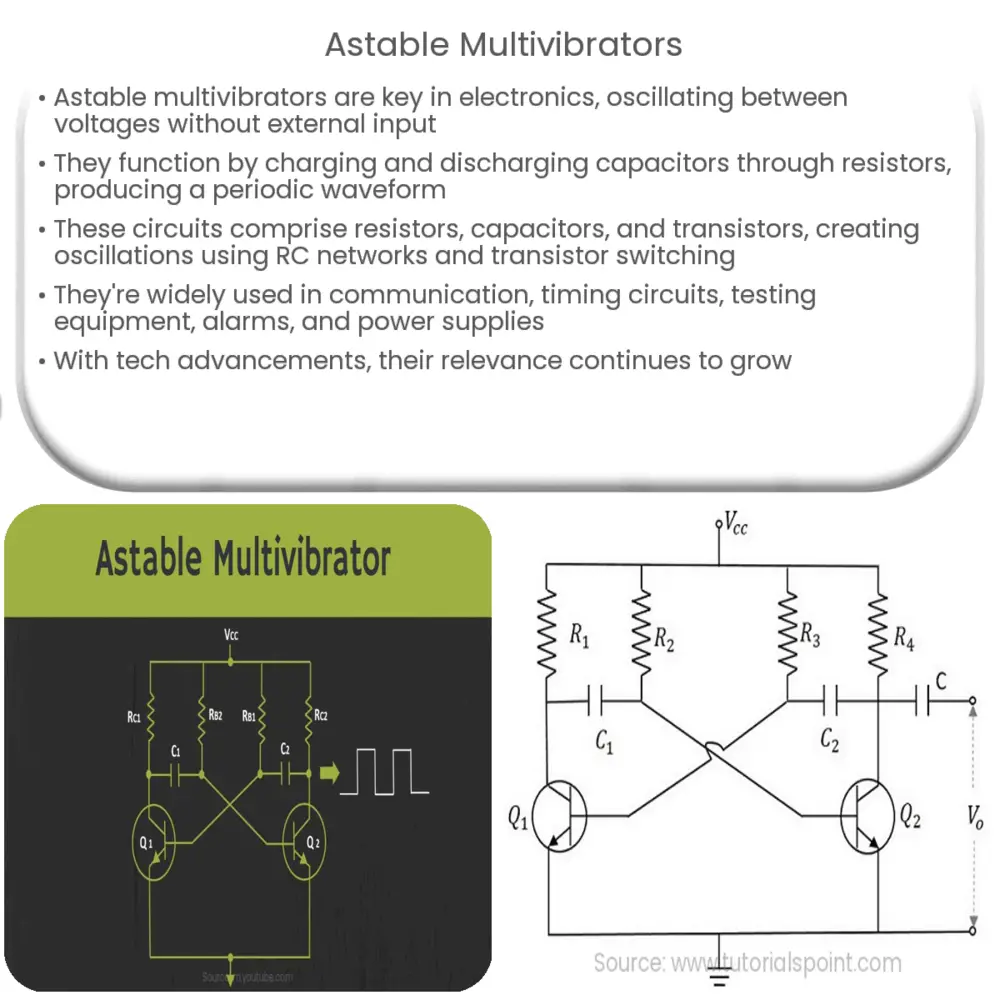Explore the world of astable multivibrators, their working principle, circuit design, applications, and role in modern electronics.

Astable Multivibrators: A Primer
An astable multivibrator is a core component within the realm of electronic circuit design. It’s a type of oscillator that oscillates between two voltage levels without any external triggering, hence its name: ‘Astable,’ which means ‘not stable’ in the absence of external input.
Working Principle of Astable Multivibrators
The basic principle behind astable multivibrators involves the charging and discharging of capacitors through resistors, which create a feedback mechanism. This process generates a periodic waveform, commonly a square wave or a pulse, that oscillates indefinitely until the power is cut off.
Components of an Astable Multivibrator
- Resistors: These are key to controlling the charging and discharging time of the capacitor, which in turn determines the output frequency of the oscillation.
- Capacitors: These store and release electrical energy, creating the charging and discharging cycles that drive the multivibrator’s oscillations.
- Transistors: Act as electronic switches to control the direction of current flow, thus enabling the switching between two states of the multivibrator.
These components work together, leveraging the properties of RC (Resistor-Capacitor) networks and transistor switching, to create a stable, predictable oscillation without the need for any external input signal.
Astable Multivibrator Circuit Design
In a typical astable multivibrator design, two transistors are cross-coupled in such a way that the output from one feeds into the other. This arrangement ensures that the transistors are alternately switched on and off, driving the cyclical behavior. The combination of resistors and capacitors forms a timing network, which determines the period of oscillation.
The output frequency of an astable multivibrator can be calculated using the formula:
f = 1 / T = 1.44 / ((R1 + 2R2) * C1)
Here, R1, R2 are the resistors and C1 is the capacitor. The ‘1.44’ is a constant derived from the natural logarithm base (e), showing the integral role of exponential growth in the circuit’s function.
Applications of Astable Multivibrators
Astable multivibrators have widespread usage across a variety of domains…
Applications of Astable Multivibrators
- Communication Systems: Astable multivibrators are often used in frequency generation and modulation, key aspects of radio and telecommunication systems.
- Timing Circuits: The predictable oscillations of an astable multivibrator make it ideal for use in timing and control circuits.
- Testing Equipment: In electronic testing equipment, these circuits can serve as signal generators to provide inputs for device testing.
- Alarm Systems: The multivibrators are also used in alarm systems, where a continuous signal is needed.
- Power Supplies: They are commonly found in switching power supplies, where they act as oscillators.
Astable Multivibrators vs. Monostable and Bistable Multivibrators
Besides astable multivibrators, two other types exist: monostable and bistable multivibrators. Monostable multivibrators have one stable state and require an external trigger to change states temporarily. Bistable multivibrators, also known as flip-flops, have two stable states and require external triggers to switch between them. In contrast, the astable multivibrator oscillates between its two states without any external trigger, providing a continuous square wave output.
Future of Astable Multivibrators
With the rise of new technologies, the traditional design of astable multivibrators has been adapted and modified to better fit the demands of modern electronics. Developments in integrated circuit (IC) technologies have led to more compact and efficient designs, and the use of software simulation has enabled more complex and precise control over the astable multivibrator’s behaviour. As we push towards an increasingly digital future, the utility and relevance of this simple yet versatile circuit will only continue to grow.
Conclusion
As we’ve seen, astable multivibrators hold a critical position in electronic circuit design due to their self-driven oscillatory nature. By alternating between two voltage levels, they create the rhythm behind numerous electronic systems, from communication devices to alarm systems. Their design, which is elegant in its simplicity, provides a perfect demonstration of how capacitors, resistors, and transistors can work in harmony to achieve a larger function. With continuous advancements in technology, astable multivibrators promise to remain an integral part of our electronic future.

